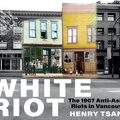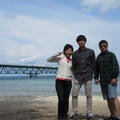My childhood friend, Jiro Takai, and I have been on parallel life paths of sorts.
We first met in elementary school in Sault Ste. Marie (the Soo), northern Ontario, Canada. Growing up, unbeknownst to each other, we would forge careers in education. Having since reconnected in recent years, Jiro has become a wonderful friend and ally.
Over the decades, our lives have crisscrossed many times from Canada to Japan, back to Canada and Japan again… the tettertottering between cultures continues.
As I read through this interview again, it is sobering to realize just how the world has changed but also how much more still needs to change as our worlds shift, including the place of BIPOC and LGBTQ+ people in them as staunch colonial power structures slowly crumble.
As such, Jiro and I have grown up against a backdrop of world events, including: the 1960s American civil rights movement, the Vietnam War in the ‘70s; and marked by the murder of Vincent Chin (1982), the Rodney King riots (“Sa-I-Gu” in Korean, 1992), and more recently, the murders of George Floyd and Breonna Taylor (2020). Each in a way has helped to shape who we are as just two regular Asian guys, amazed that we’ve made it this far, and our place in these ever changing times.
* * * * *
Moving to Canada
After graduating from Kyoto University with a PhD, Jiro’s dad, Shozo, a plant pathologist, worked at the National Forestry Research Center in Meguro, Tokyo. “His research involved Dutch Elm Disease, a disease transmitted by beetles, which almost wiped out elm trees from the face of the earth back in the 1960s and 1970s,” explains Jiro, who was born in Meguro.
Shozo decided to do a year-long sabbatical at the University of Saskatchewan (U of S). It was while there that he applied for a position at the Canadian Forestry Service in Ste. Foy, Quebec. Jiro remembers that after returning to Tokyo from the U of S for a couple months that his dad “dropped the bomb” announcing that they were going back to Canada. Jiro recalled:
JT (Jiro Takai): I still remember my mom being so irate at him for making the decision without consulting her. My brother and I were pretty excited to be leaving Japan, as my dad was promising we would be living in a big house, with our own car, the ones that only yakuzas and politicians would be riding around in at that time.
At the time, Japan was a backward country, compared to Canada. I came from a beat up shack of a townhouse, with only one bedroom for a family of four, and a toilet that was essentially a hole in the ground. You open the lid, and there would be flies popping out, not to mention the stench of the cesspool, yes, literally a cesspool. So-called “vacuum trucks” would come by to suck up that disgusting sewage, leaving a pungent trail throughout our neighbourhood.
Of course, the roads, if you can call them that, were not paved, and I still have a nasty scar on my knee when I fell, and gashed my skin on a piece of broken glass that was embedded in the hardened soil of the avenue. Cars were taxis, as nobody I knew had their own, hence driveways and garages were never heard of.
The only milk I had was powdered, mixed with water. The tonkatsu was basically a thick oil drenched bread crumb layer, with only a paper thin slice of pork, a far cry from the thick, juicy pork cutlets we could have in Canada. I remember we ate a lot of konnyaku, as a substitute for meat. God, that stuff stank.
So here we were in Ste. Foy. Cars! Lots of them, driving on wide multi-lane paved boulevards. And they were huge, not like the Hillman-Isuzu Minx we were used to, which by the way were taxis.
Our house (yeah, a house) was three bedrooms, with a bathtub and shower (we only bathed a couple times a week at a public bathhouse in Tokyo for lack of these), and the toilet… You sat on it, not squat! Japanese toilets of the time made you feel like a dog (now it’s the opposite, the toilet being my pet peeve when I visit Canada). No sleeping on the floor, no roaches, no worrying about getting bit by ticks and mites (the infamous dani), and no noise from your annoying couple next door having an intimate moment, if not a loud argument.
“In Quebec, we actually had a grassed lawn between us and the house next door, the size of which you can make an ice rink to practice your skating, which me and my brother actually did. This was the good life. From the Third World to Utopia.
We bought a car, by the way, a 1966 Meteor Rideau 500 that was made in Oakville, ON. Lasted two years before the transmission quit out. Maybe the Hillman-Isuzu Minx would have been a better choice. For replacement, we bought a faux-Pontiac, the Parisienne assembled in Oshawa, which was actually a Chevy in Pontiac skin, in order to avoid tariffs should they had been imported from Detroit.
Nonetheless, it was a great car, and in high school, it became mine. I balled my eyes out when I had to sell it after 14 years growing up with it. Still running in perfect shape, but with lots of Bondo to bury the rust holes.
Back then, Quebec City was totally French, amidst the “maitre chez nous” movement. The locals would not acknowledge your presence unless you at least tried to speak in French. As a kindergarten tyke, I picked up on French real fast.
Good thing, too, because one time, I fell down the stairs of our backyard, and cut my face up on the fence really bad. I was bleeding profusely, and my dad freaked out. He called the operator for an ambulance in English since he knew no French. They only talked back to him in French, and after a few exchanges, they hung up on him. I ended up in the back seat of the Meteor, which luckily, took me to the hospital without breaking down for a change.
At the hospital, my dad explained the situation, again in English, and of course, the staff ignored him, so I said to them feebly, “Je saigne à mort.” That’s all it took to get them moving, and within several minutes, a doctor was sewing my face up.
Arriving in the Soo
The Takai family arrived in the Soo in 1970 from Ste. Foy, Quebec, where the Ibukis were already living. That’s where Jiro and I first met.
JT: Perhaps my dad had enough of the silent treatment toward the ne parle pas français. He sought a transfer to English Canada. In the summer of 1970, we were off to Sault Ste. Marie (the “Soo”). It was like moving to California for Americans, as Ontario was the richest, most happening province in Canada, and promising lots of excitement.
As a matter of fact, we were in such a rush to get out of the province of Quebec that my dad did not even bother looking for a house before we set off, and we spent a month at a vacation rental cottage on Lake Superior, while he bid for a house. Ste. Foy only had a river, a murky leech infested one at that, so you can imagine what delight the clear waters of Batchawana Bay seemed.
© 2023 Norm Ibuki






